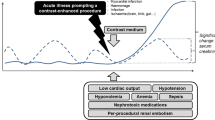Abstract
The major current problem related to radiological contrast media is how best to achieve the optimum cost benefit efficiency in the deployment of contrast agents. Low osmolar contrast media (LOCM) are more comfortable for the patient and cause less adverse reactions than high osmolar contrast media (HOCM), but there is no statistically proven reduction in mortality. There is no improvement in diagnostic intravascular imaging when LOCM replaces HOCM. LOCM are 4–5 times more expensive than HOCM.
It is therefore proposed that, until adequate finances become available, HOCM might well continue to be utilised for routine injections for intravenous urography (IVU), computed tomography (CT) and for visceral angiography, reserving LOCM for high-risk patients, high-risk procedures and for painful procedures.
Similar content being viewed by others
References
Grainger RG, Dawson P (1990) Editorial. Low osmolar contrast media: An appraisal. Clin Radiol 42: 1–5
Dawson P, Grainger RG (1991) Letter. Medico-legal implications of contrast media choice. Clin Radiol 43: 435–436
Evens RG (1987) An economic study of low osmolality contrast. Diagn Imaging Suppl 9: 19–21
Gouvernement du Québec (1989) Conseil d'évaluation des technologies de la santé du Québec. Evaluation of low vs high osmolar contrast media. Technical document. Québec
Katayama M, Yamaguchi K, Kozuka T, Takashima T, Seez P, Matsuura K (1990) Adverse reactions to ionic and non-ionic contrast media: A report from the Japanese Committee on the safety of contrast media. Radiology 175: 621–628
Stiris MG, Laerum F (1987) Iohexol and ioxaglate in peripheral angiography. Acta Radiol 28: 767–770
Palmer FJ (1988) The RACR survey of intravenous contrast media reactions. Final report. Australas Radiol 32: 426–428
Grainger RG (1984) The clinical and financial implications of low osmolar media. Clin Radiol 36: 251–252
Caro JJ, Trinidade E, McGregor M (1991) The risks of death and of severe non-fatal reactions with high vs low osmolality contrast media. A meta-analysis. AJR 156: 825–832
Curry NS, Schabel SI, Reiheld CT, Henry WD, Savoca WJ (1991) Fatal reactions to intravenous non-ionic contrast material. Radiology 178: 361–362
Stormorken H, Skalpe IO, Testart MC (1986) Effects of various contrast media on coagulation, fibrinolysis and platelet function: an in-vitro and in-vivo study. Invest Radiol 21: 348–354
Doorey AJ (1991) Clinical Aspects of contrast media. J Invas Cardiol 3 Suppl B, 60B-66B
Author information
Authors and Affiliations
Additional information
Offprint requests to: R. G. Grainger
Rights and permissions
About this article
Cite this article
Grainger, R.G. Optimum utilisation of intravascular radiological contrast media. Eur. Radiol. 2, 121–123 (1992). https://doi.org/10.1007/BF00171397
Issue Date:
DOI: https://doi.org/10.1007/BF00171397




